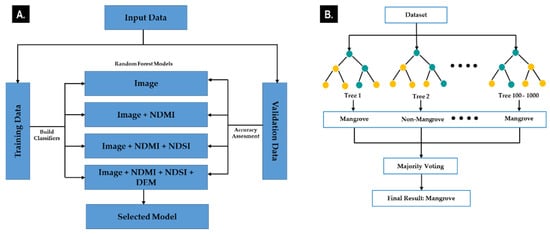Abstract
Sembilang National Park, one of the best and largest mangrove areas in Indonesia, is very vulnerable to disturbance by community activities. Changes in the dynamic condition of mangrove forests in Sembilang National Park must be quickly and easily accompanied by mangrove monitoring efforts. One way to monitor mangrove forests is to use remote sensing technology. Recently, machine-learning classification techniques have been widely used to classify mangrove forests. This study aims to investigate the ability of decision tree (DT) and random forest (RF) machine-learning algorithms to determine the mangrove forest distribution in Sembilang National Park. The satellite data used are Landsat-7 ETM+ acquired on 30 June 2002 and Landsat-8 OLI acquired on 9 September 2019, as well as supporting data such as SPOT 6/7 image acquired in 2020–2021, MERIT DEM and an existing mangrove map. The pre-processing includes radiometric and atmospheric corrections performed using the semi-automatic classification plugin contained in Quantum GIS. We applied decision tree and random forest algorithms to classify the mangrove forest. In the DT algorithm, threshold analysis is carried out to obtain the most optimal threshold value in distinguishing mangrove and non-mangrove objects. Here, the use of DT and RF algorithms involves several important parameters, namely, the normalized difference moisture index (NDMI), normalized difference soil index (NDSI), near-infrared (NIR) band, and digital elevation model (DEM) data. The results of DT and RF classification from Landsat-7 ETM+ and Landsat-8 OLI images show similarities regarding mangrove spatial distribution. The DT classification algorithm with the parameter combination NDMI + NDSI + DEM is very effective in classifying Landsat-7 ETM+ image, while the parameter combination NDMI + NIR is very effective in classifying Landsat-8 OLI image. The RF classification algorithm with the parameter Image (6 bands), the number of trees = 100, the number of variables predictor (mtry) is square root (), and the minimum number of node sizes = 6, provides the highest overall accuracy for Landsat-7 ETM+ image, while combining Image (7 bands) + NDMI + NDSI + DEM parameters with the number of trees = 100, mtry = all variables (), and the minimum node size = 6 provides the highest overall accuracy for Landsat-8 OLI image. The overall classification accuracy is higher when using the RF algorithm (99.12%) instead of DT (92.82%) for the Landsat-7 ETM+ image, but it is slightly higher when using the DT algorithm (98.34%) instead of the RF algorithm (97.79%) for the Landsat-8 OLI image. The overall RF classification algorithm outperforms DT because all RF classification model parameters provide a higher producer accuracy in mapping mangrove forests. This development of the classification method should support the monitoring and rehabilitation programs of mangroves more quickly and easily, particularly in Indonesia.
1. Introduction
Mangroves are us [1]. This phrase provides an understanding of how important mangrove forests are in maintaining the balance of nature. Mangrove forests are unique and productive ecosystems in coastal areas, particularly in tropical and sub-tropical areas that play an important role in the surrounding ecosystem and provide coastal ecosystem services and social functions to coastal communities [2,3,4,5]. Efforts to conserve mangrove forests are increasing, one of which is in Indonesia [6]. Mangrove forests in Indonesia make a substantial contribution to climate change mitigation efforts [7] and are a major topic of environmental development [8].
Indonesia is known as the largest home to the world’s mangrove communities [9]. Mangrove forests in Indonesia are among the world’s largest, accounting for approximately 18%–23% and approximately 59.8% of the total mangrove area on Earth [4,10,11] and in Southeast Asia [12,13], respectively. Mangrove forests provide many benefits, including the ability to store carbon stocks, prevent disasters, erosion, and seawater intrusion, maintain a stable coastline, reduce tsunami waves by 50%–60%, and provide spawning and breeding grounds for marine biota as well as a source of food for plankton [14,15,16,17].
One of the largest potentials of mangrove ecosystems in Indonesia is in Sembilang National Park, Banyuasin Regency, South Sumatra Province. Mangrove forests grow well in this region because Sembilang National Park is located in the Banyuasin Peninsula [13], and its position is relatively protected from large ocean waves. Although they have excellent growth potential, mangrove forests are inseparable from various things that can disturb their sustainability. For centuries, the main problems experienced by vegetation in coastal areas globally are the conversion of habitat to aquaculture, agriculture, tourism, forest over-exploitation, industrial, upstream dams, dredging, and urban development [3,4,7]. The degradation of mangrove forests in South Sumatra Province is due to land use conversion for coconut and oil palm plantations, fishponds, ports and settlements [17]. One of the disturbances occurring in Sembilang National Park is related to illegal logging [18,19], as shown in Figure 1. Additionally, forest fires in Sumatra Island in 1997 also had a considerable impact on the existence of Sembilang National Park. Therefore, the Government of Indonesia has issued laws and regulations relating to the prevention and control of forest fires to support the mangrove forest rehabilitation program in Sembilang National Park [13,20]. However, these efforts must be supported by monitoring the mangrove forest and its surrounding environment.
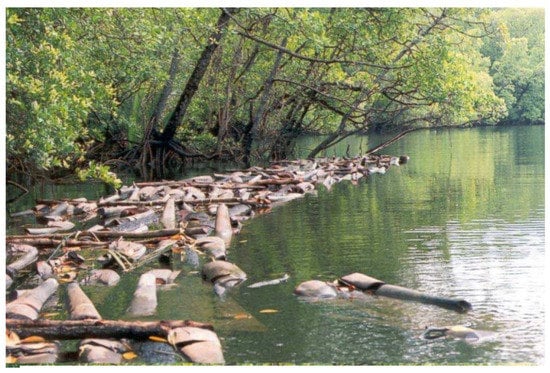
Figure 1.
Timber logging from mangrove forests in Sembilang National Park [19].
Fast and accurate mangrove mapping can help in effectively managing and monitoring mangrove forests [21]. Given the high distribution of mangrove forests, monitoring is not possible using conventional methods because it requires a very large effort regarding energy, time, and cost [21]. Conventional methods are generally conducted using estimation methods performed by experts and terrestrial measurements [22]. The combination of remote sensing technology and the geographical information system (GIS) is very effectively used in environmental modeling, particularly in supporting resource management, environmental risk assessment, and the prediction and analysis of the impact of global environmental changes [23]. This technology can provide convenience in the process of identifying mangrove forest objects [24,25].
Several studies have used remote sensing data to monitor changes in mangrove forests [25,26,27,28]. Kuenzer et al. (2011) [5] explained that the pixel spectrum in mangrove objects is influenced by the pixel fraction of leaves, stems, branches, mud, and water surfaces. Zhang et al. (2017) [21] added that a mangrove spectral value comprises a combination of information related to vegetation and wetland conditions that characterize mangrove habitats. On the basis of the spectral response from remote sensing imagery, near-infrared (NIR) and shortwave infrared (SWIR) bands are very optimally used to identify mangrove forests because mangrove vegetation characteristics reflect strongly on NIR waves, and mangrove wetland habitat conditions absorb energy from SWIR waves [29,30]. Xiao et al. (2021) [31] noted that SWIR, NIR, and red bands, are very effective in separating mangrove objects from other vegetation. The reflectance level of the SWIR band is lower in mangrove forests than in terrestrial forests [21]. Additionally, several vegetation indices can be used to determine the condition of vegetation land cover [32], including the normalized difference moisture index (NDMI) and the normalized difference soil index (NDSI). NDMI can calculate the water content of vegetation by optimizing the presence of NIR and SWIR bands [21,33,34,35], while NDSI focuses on determining soil condition information (non-mangrove) [36,37]. However, these two vegetation indices have never been combined to identify mangrove forests. A novelty of this study is trying to optimize the combination of NDMI and NDSI parameters to separate mangrove and non-mangrove objects. Using digital elevation model (DEM) data can also help in determining the location of mangrove forests, which are generally found at elevations of less than 10 m [21,26]. This ancillary data is an important variable because it has a diverse distribution of values and may be highly correlated with the ecological environment of a mangrove forest [26,38]. The selection of parameters from visible, NIR, and SWIR bands, as well as DEM, aims to make it easy for applying in another image that previously needed to be adjusted to the threshold value according to the image data used, and also the location of the mangrove habitat.
The development of image classification techniques is increasing rapidly along with the many choices of classification algorithms with several advantages and weaknesses. Pixel-based classification method performance is quite reliable in separating objects based on spectral values, but salt and pepper effects are often found in the classification results [39,40]. Although the object-based classification method has advantages and can cover the weaknesses of pixel-based classification, some obstacles remain, including those related to the available software options, which are still too complicated, and many challenges remain, particularly in processing very big data [41]. Recently, the use of machine-learning-based classification algorithms to classify mangrove forests has also developed. The support vector machine (SVM) algorithm can be used to map mangrove forests, and it produces an acceptable level of accuracy [13,42,43]. Additionally, the use of the decision tree (DT) algorithm can produce high accuracy in distinguishing mangrove and non-mangrove objects [21,26,44]. Random forest (RF) is a machine-learning algorithm that can considerably increase the accuracy of pattern recognition [45]. SVM requires relatively longer computations than the decision tree, while random forest is able to handle training data samples in large quantities faster, and can reduce the misclassification of mangrove forests very well [42,46]. Jamaluddin et al. (2022) [25] used the RF algorithm to monitor mangrove degradation in East Luwu, Indonesia, with very high accuracy (greater than 90%). Mondal et al. (2019) [47] used two machine-learning algorithms (DT and RF) to map mangroves in West Africa.
The location of Sembilang National Park, adjacent to a peat swamp forest [13,48] and oil palm plantations, creates a challenge in classifying mangrove and non-mangrove objects using remote sensing satellite data. Several different objects have the same spectral characteristics, which often confuses their recognition [49]. This confusion causes the misclassification of mangrove and non-mangrove objects, such that the level of classification accuracy is reduced. The objects of oil palm plantations, peat swamp forests, and other land vegetation that should be classified in the non-mangrove class are actually considered mangroves. Therefore, we need a knowledge-based classification approach by integrating remote sensing technology and the GIS, as well as ancillary data through the concept of developing a simple DT learning to separate mangrove objects from non-mangrove objects by minimizing the presence of mixed pixels. The knowledge-based classification approach through the development of rules is increasingly interesting because it can accommodate various data sources [50]. Several studies have developed a DT learning algorithm to identify mangrove forests using Landsat TM, ETM+, and OLI images, and produce high accuracy [21,24,26,51].
This study aims to investigate the ability of DT and RF algorithms in identifying the distribution of mangrove forests in Sembilang National Park, Banyuasin Regency, South Sumatra Province, Indonesia. A previous study (Mondal et al. 2019) was limited to running the algorithms available in the cloud computing platform with the classification input using a spectral band of satellite image and the Normalized Difference Vegetation Index (NDVI), but not involving the use of physical parameter (DEM). Therefore, the present study will try to develop a classification algorithm involving several important parameters (multiple spectral indices and DEM) to obtain the optimal classification model. Additionally, an increasingly simple DT learning algorithm can help in quickly and easily mapping mangrove forests. The DT concept can provide an understanding of the classification process performed through the developed classification rules and minimize human intervention [26]. Some of the benefits and weaknesses of the two machine-learning algorithms will be investigated and analyzed in depth. The developed method should produce information on mangrove distribution with high accuracy and can support mangrove management and the national mangrove rehabilitation program in Indonesia.
2. Materials and Methods
2.1. Study Area
The study area is located in Sembilang National Park, Banyuasin, South Sumatra Province, Indonesia, with the coordinates of 104°19′–104°45′E and 1°42′–2°10′S, and is bordered by Musi Banyuasin Regency to the west and south, Muarojambi and Tanjung Jabung Timur Regencies to the north, and Bangka Strait to the east (Figure 2). Sembilang National Park is the best and largest mangrove area on the island of Sumatra (western part of Indonesia) [9,52] and the Indo–Malayan region [53,54,55]. Mangrove ecosystem is the main and most dominant ecosystem in Sembilang National Park, which is able to absorb carbon very well through the photosynthesis process [56]. Mongabay (2018) [57] reports that the function of mangrove forest as a spawning ground and a source of fish food is strongly felt by fishermen around in Sembilang National Park, so that many fishermen catch fish around the mangrove forest location. In addition, the mangrove forest in Sembilang National Park is also the main habitat for about 44 bird species including migrants from Siberia. Other benefits that are felt from the existence of mangrove forests in Sembilang National Park include being able to prevent coastal abrasion and protect coastal communities from property damage due to storms [58]. The condition of mangrove forests in Sembilang National Park is also very dynamic and changes annually [13]. Several groups of mangrove genera can be found at this location, including Avicennia, Rhizopora, Bruguierra, Sonneratia, Ceriops, and Xylocarpus, in which Avicennia and Rhizopora are the dominant genera throughout almost all of Sembilang National Park [9,13,59]. Additionally, many species of Nypa fruticans and shrubs are present [9]. Sembilang National Park undergoes two seasons a year, namely, a rainy season with an average rainfall of 2.723 mm/year [60] and a dry season. Several large rivers are found in the Sembilang National Park region that function as a means of water transportation along the coastline. The tidal type at the study site is diurnal: one high tide and one low tide occur daily [61].
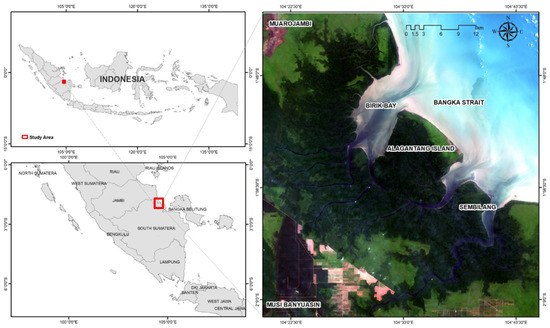
Figure 2.
Study area located in Sembilang National Park, Banyuasin, Indonesia.
2.2. Satellite Data
The satellite data used in this study are Landsat 7 ETM+ image acquired on 30 June 2002, and Landsat 8 OLI image acquired on 9 September 2019, with path 124 and row 061 obtained from the United States Geological Survey (USGS) website at https://earthexplorer.usgs.gov (accessed on 3 February 2022). The selection of the date of the image data is based on the minimum cloud cover condition, especially at the study location. In June and September, Indonesia enters the dry season so that in these months the cloud cover is relatively less than the wet season. Besides, it is also intended to see the spatial changes of mangroves and the surroundings in a period of 17 years. In 2002, the land cover conditions around mangrove forests were relatively homogeneous, but in 2019 it look more heterogeneous where the oil palm plantation objects began to be found which pose challenges in developing a classification model for mangrove and non-mangrove forests. Based on the tidal prediction data, it also shows that on these dates the condition of the waters at the study location is at low tide. Additionally, we used SPOT 6/7 images recorded in 2020–2021 obtained from the National Research and Innovation Agency. SPOT 6/7 images are used to assist in determining the training sample and ground truth points. A flow chart of this study is shown in Figure 3.
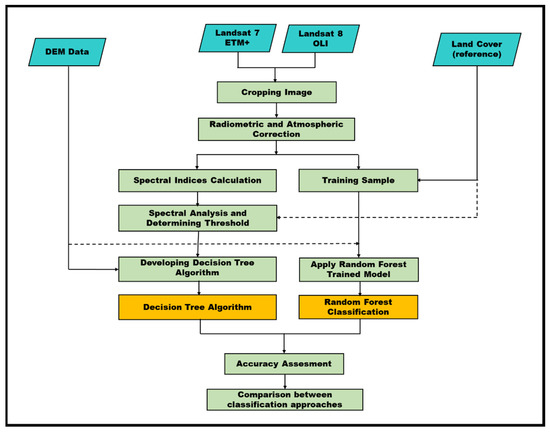
Figure 3.
Study flow chart.
Additionally, we used an administrative boundary map of 1:50,000, an existing mangrove map, and DEM data. The regional administrative boundary map was obtained from the Geospatial Information Agency. Existing mangrove maps were obtained from the Ministry of Forestry and Environment. The DEM data used is the multi-error removed improved terrain (MERIT DEM) developed by Yamazaki et al. (2017) [62]. Then, we resampled the spatial resolution of DEM data from 90 m to 30 m using ArcMap 10.4. The MERIT DEM data were retrieved from the Yamazaki Lab website at http://hydro.iis.u-tokyo.ac.jp/~yamadai/MERIT_DEM (accessed on 21 February 2022). Threshold DEM values for mangrove areas (below 10 m) were based on Liu et al. (2008) [26] and Zhang et al. (2017) [21] and modified to suit the condition of the mangrove area in the study location (<12 m).
2.3. Method
Overall, the methodology in this study, including pre-processing, spectral indices calculation, spectral analysis and determining the threshold, developing DT and RF algorithms, and accuracy assessment, is shown in Figure 3.
2.3.1. Pre-Processing
Initial data processing includes radiometric and atmospheric corrections performed using the semi-automatic classification plugin contained in the open-source Quantum GIS software developed by Congedo (2016, 2021) [63,64]. Radiometric correction addresses the worsening of image quality due to reflection errors or other factors that are very useful for multi-temporal and multi-sensor data analysis [65,66]. The radiometric correction process is performed by converting the digital number of an image into a reflectance value [67]. Atmospheric correction is a fundamental pre-analysis stage in any quantitative analysis that aims to eliminate atmospheric effects [68,69]. The Atmospheric correction method used is Dark of Substraction (DOS), which is a simple atmospheric correction [63].
2.3.2. Spectral Indices
After the pre-processing stage is performed, the next stage is the calculation of the spectral indices to facilitate the initial identification of mangrove and non-mangrove objects. In this study, two spectral indices were used, the (1) NDMI and (2) the NDSI with the following equations:
where is the reflectance value of the NIR band for Landsat 7 ETM+ and OLI, while is the reflectance value of the SWIR1 band (1.547–1.748 µm) for Landsat 7 ETM+ and SWIR2 (2.100–2.300 µm) for Landsat 8 OLI.
where is the reflectance value of the SWIR1 band for Landsat 7 ETM+ and Landsat 8 OLI, while is the reflectance value of the NIR band for Landsat 7 ETM+ and OLI.
2.3.3. Decision Tree Algorithm
Decision trees have been widely used for land cover classification, particularly with remote sensing technology approaches [70], and are often used to integrate multi-source data, such as optical imagery and SAR [71,72,73]. Several previous studies have also developed a DT algorithm to identify the presence of mangrove forests [21,26]. The DT is defined as a machine-learning-based analysis technique comprising several classes of modeling algorithms using a tree structure, in which each node shows a test on attributes, the branch represents the test results, and the leaf node shows the target classes [26,74,75]. In practice, the DT concept is often translated using classification rules [38], as shown in Figure 4. The DT does not depend on specific assumptions about variable distribution, or it can be said that the relationship between variables is independent [21,26]. Three stages are used to build the classification rules according to Hodgson et al. (2003) [76], including: (1) generating and perfecting knowledge and rules from experts; (2) extracting variables and rules using cognitive methods; and (3) automatically generating rules from observed data.
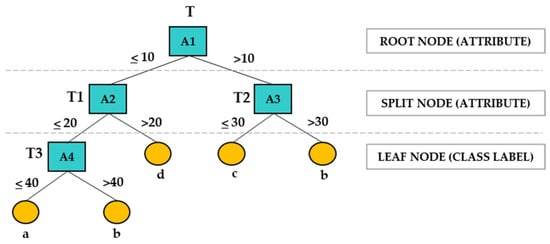
Figure 4.
Decision tree algorithm concept (adapted from Figure 1 in Liu et al. 2008 [26]).
The concept of the DT algorithm is stated with classification rules as a statement “IF <condition> THEN <action>”. For example, the classification rule of the DT algorithm in Figure 4 can be written as follows:
- (1)
- IF: (A1 > 10) and (A3 ≤ 30) THEN class = c
- (2)
- IF: (A1 ≤ 10) and (A2 ≤ 20) and (A4 > 40) THEN class = b
The initial stages of the DT classification process in this study are spectral analysis and threshold determination. The analysis was performed by first conducting training data by drawing transect lines randomly in the mangrove area and proportionally distributed in the study area. The determination of transect lines was based on available field data, existing mangrove maps, SPOT 6/7 images, and Google Earth. The collected training data amounted to 1341 points. Furthermore, collected training data are used in training the DT, namely, determining attributes and thresholds at each node [26]. The transect line is drawn to determine the spectral profile in each pixel so that it can be compared with the spectral values in other pixels [77]. The transect line method has also been used by Madden (2011) [78] to determine the spectral profile of shallow marine habitats. The number of pixels refers to a completely homogeneous sample of mangroves. The threshold value refers to the minimum and maximum values for each parameter. The next stage is overlay between Landsat image bands starting from visible bands (blue, green, and red), NIR bands, and SWIR bands, as well as spectral indices (NDMI and NDSI) with transect lines that have been drawn to extract spectral values along the transect line. Then, the extraction results of spectral values in each band and spectral indices are overlaid with the existing mangrove map to obtain the optimal threshold value in distinguishing mangrove and non-mangrove objects. Existing mangrove map is produced through visual interpretation and field survey conducted by GIS experts at the Ministry of Environment and Forestry and assisted by several stakeholders. In addition to obtaining the optimal threshold value for mangrove objects, the use of existing mangrove map can also minimize the presence of mixed pixels. In short, the implementation of the DT algorithm by partitioning all target classes is based on the threshold value of the image spectral value, NDMI, NDSI, and elevation values that have been obtained previously. Additionally, it is supported by visual interpretation using high-resolution image data and expert knowledge in the study area.
2.3.4. Random Forest Algorithm
The random forest algorithm is growing and has been widely used in land use/land cover classification, particularly for mangrove forests [79]. The RF is a machine-learning algorithm that can substantially improve pattern recognition accuracy [45]. RF has been successfully applied in ecological research [80,81]. Each DT provides calculations on the most dominant class unit to classify certain classes according to the training data input [82,83]. The combination of information from satellite data and field data is used as a basis for preparing training data that will subsequently become input in the classification model [84]. The training data process and RF classification in this study were performed using the Vigra tool contained in the open-source software SAGA 7.6.2 [85,86], with a total amount of training data of 1135 pixels for Landsat-7 ETM+ and 1285 pixels for Landsat-8 OLI. For the initial stage, we performed tuning on several parameters, including the number of trees, the number of predictor variables (mtry), and minimum node size to obtain optimal mangrove and non-mangrove classification models. This study used the number of trees of as much as 100, 500, and 1000 [87,88,89], mtry = (square root) and mtry = k (all variables) [45,86], and a minimum node size of 6. The application of the RF algorithm in previous studies with the parameters of the number of trees = 1000, mtry = all, and minimum node size = 6 produces an overall accuracy of 79.333% with a kappa statistic of 0.774 in mapping the distribution of coffee plantations [86]. The combination of parameter settings in the dataset produces 31 classification models for Landsat-7 ETM+ and Landsat-8 OLI images, which will later be investigated to obtain the best classification model and have high accuracy. The dataset used in the RF classification algorithm is derived from a combination of Landsat-7 ETM+ and Landsat-8 OLI image spectral values and NDMI, NDSI, and DEM data, as shown in Table 1.

Table 1.
Dataset used in the random forest classification.
The classification process using the RF algorithm is illustrated in Figure 5.
3. Results
This study focuses on using Landsat satellite imagery to identify mangrove distribution more quickly and easily in order to support the monitoring and rehabilitation program of mangroves in Indonesia on a medium scale (1:100,000). The available SPOT 6/7 images are only used to assist in determining the training sample and ground truth points. In addition, the SPOT 6/7 image data does not fully cover one study location only around 50% of the study area.
3.1. Decision Tree Algorithm for Identifying Mangrove Forests
Two rules and knowledge-based classification were applied in the DT algorithm to distinguish between mangrove and non-mangrove objects based on Landsat-7 ETM+ and Landsat-8 OLI images. The development of the DT algorithm begins by recognizing the spectral character of both Landsat images used (bands 1–7, except for the thermal band), NDMI, and NDSI. The spectral profile of each parameter is shown in Figure 6. The NIR band had the highest reflection compared to other bands. Additionally, the SWIR-1 and SWIR-2 bands also show relatively high reflectance but not as high as the NIR band (Figure 6A,B). The effective NIR band reflectance value range for identifying mangrove forest objects was 0.20–0.30 with an average value of 0.25 (Landsat 7 ETM+) and 0.26–0.35 with an average value of 0.28 (Landsat-8 OLI). The effective SWIR-1 band spectral reflectance value range for mangrove forest identification was 0.05–0.10 with an average value of 0.07 (Landsat-7 ETM+) and 0.05–0.12 with an average value of 0.08 (Landsat-8 OLI), while the range of the reflectance value of the effective SWIR-2 band for mangrove identification was between 0.03 and 0.05 with an average value of 0.03 (Landsat-7 ETM+) and 0.02–0.05 with an average value of 0.03 (Landsat-8 OLI). The spectral reflectance of visible bands (blue, green, and red) shows a lower value than those of the NIR and SWIR bands.
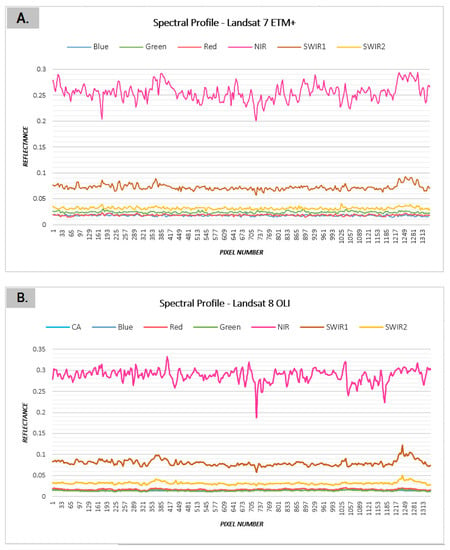
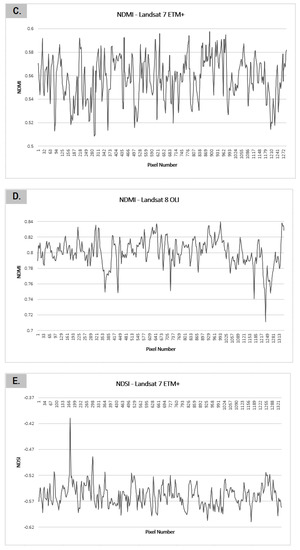
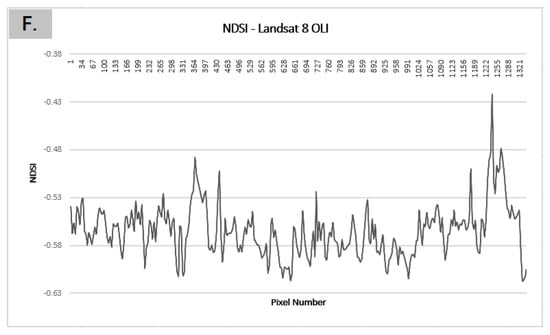
Figure 6.
Characteristics of the mangrove object spectral value. (A) Spectral Bands of Landsat–7 ETM+ (B) Spectral Bands of Landsat–8 OLI (C) Normalized difference moisture index (NDMI) of Landsat–7 ETM+ (D) Normalized difference moisture index (NDMI) of Landsat–8 OLI (E) Normalized difference soil index (NDSI) of Landsat–7 ETM+ (F) Normalized difference soil index (NDSI) of Landsat–8 OLI.
The identification of mangrove forests was still difficult if we only used several bands from the Landsat image. In addition, the possibility of mixed-pixel pixels existed in which pixels from mangrove and non-mangrove objects were mixed. Therefore, the NDMI and NDSI spectral indices derived from Equations (1) and (2) must be used. Figure 6C,D show the NDMI spectral profiles of the Landsat-7 ETM+ image between 0.51 and 0.60 with an average value of 0.55 and the Landsat-8 OLI image between 0.75 and 0.9 with an average value of 0.80. The spectral value on NDSI ranges from (−0.65) to (−0.475) with an average value of −0.55 for Landsat-7 ETM+ image, while the NDSI spectral values for Landsat-8 OLI image ranges from (−0.7) to (−0.525) with an average value of −0.56 (Figure 6E,F).
Furthermore, the previously obtained threshold values were used to make the classification rule, as shown in Figure 7. The initial approach to classifying mangroves and non-mangroves in the Landsat-7 ETM+ image (classification rule-1) (Figure 7A) was to use the NDMI parameter, in which the threshold value ranged from 0.51 to 0.60 for the mangrove class, and outside this value range was considered a non-mangrove class. The next approach was using the NDSI parameter, in which a threshold value between (−0.65) and (−0.48) was for the mangrove class, and values outside this range were considered non-mangrove classes. The last approach was to use DEM parameter in which the presence of mangrove forest objects in the study area was dominant at an elevation of 0–12 m. The classification results of each parameter from the Landsat-7 ETM+ image are shown in Figure 8A–C.
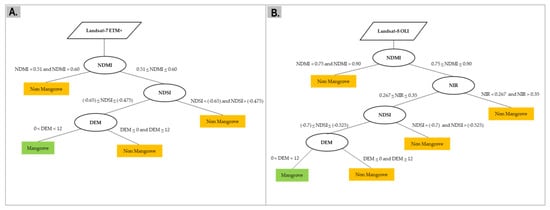
Figure 7.
Decision tree algorithm of (A) Landsat-7 ETM+ and (B) Landsat-8 OLI.
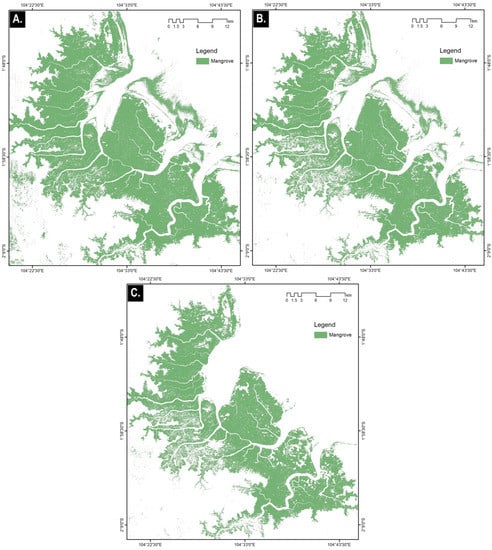
Figure 8.
Decision tree classification results of the Landsat-7 ETM+ image for parameters (A) NDMI, (B) NDMI + NDSI, and (C) NDMI + NDSI + DEM.
Mangrove identification results of the Landsat-7 ETM+ image using the NDMI parameter showed a very good distribution, but class anomalies were still found. Many mangrove and non-mangrove pixels were mixed (land vegetation and aquatic objects) (Figure 8A). An attempt to minimize this condition was made by using a combination of NDMI + NDSI parameters, but this approach was only effective in separating mangrove pixels from land vegetation object pixels, and many mangrove class anomalies were still found in aquatic objects (Figure 8B). Therefore, we used the combination of NDMI + NDSI + DEM parameters that is very effective in minimizing (even eliminating) mangrove pixels mixed with pixels of aquatic objects (Figure 8C).
A listing of the thresholds for all metrics of Landsat-7 ETM+ and Landsat-8 OLI for classifying mangrove and non-mangrove is shown in Table 2. The approach to classifying mangroves and non-mangroves in Landsat-8 OLI image (classification rule-2) (Figure 7B) slightly differed from classification rule-1, namely, by adding the spectral value parameter of the NIR band. The initial classification stage was to use the NDMI parameter with a threshold value ranging from 0.75 to 0.90 for the mangrove class, and outside this value range was considered a non-mangrove class. The next parameter was to use the NIR band with a threshold value of 0.267–0.35 and NDSI with a threshold value of (−0.7)–(−0.525). The last parameter used was DEM with the same threshold value as classification rule-1, namely, 0–12 m. Threshold values outside the specified value range were considered non-mangrove classes. The classification results of each parameter used from Landsat-8 OLI image are shown in Figure 9A–D. Using the NDMI parameter to identify mangroves in the Landsat-8 OLI image shows a very good distribution of mangroves (Figure 9A), but some mangrove and non-mangrove pixels were still mixed, particularly on land vegetation objects (one of which is oil palm plantations). This condition was minimized by combining the NDMI parameter with the NIR band (Figure 9B). The classification results show the distribution of mangroves was not as good when using a combination of NDMI + NIR parameters instead of the NDMI parameter, but it can minimize the mixed pixels that occur quite well. Then, the remaining pixels mixed between mangrove and non-mangrove objects were minimized using a combination of other parameters, namely, NDMI + NIR + NDSI (Figure 9C) and NDMI + NIR + NDSI + DEM (Figure 9D), but the results were not substantial and tend to reduce the main pixels of mangrove objects.

Table 2.
The thresholds for all metrics of Landsat-7 ETM+ and Landsat-8 OLI.

Figure 9.
Decision tree classification results of the Landsat-8 OLI image for parameters (A) NDMI, (B) NDMI + NIR, (C) NDMI + NIR + NDSI, and (D) NDMI + NIR + NDSI + DEM.
The classification accuracy using the DT algorithm of all models generated in the Landsat-ETM+ and Landsat-8 OLI images are shown in Table 3 and Table 4, respectively. The classification model accuracy of the NDMI + NDSI + DEM parameters of the Landsat-7 ETM+ image provided the highest overall accuracy (92.82%) and kappa statistic value (0.834).

Table 3.
DT classification accuracy of all models of Landsat-7 ETM+.

Table 4.
DT classification accuracy of all models of Landsat-8 OLI.
The highest accuracy of the Landsat-8 OLI image was found in the classification model with a combination of NDMI + NIR parameters, with an overall accuracy of 98.34% and a kappa statistic value of 0.963. The classification rules that have been developed for Landsat-7 ETM+ and Landsat-8 OLI images are relatively simple and can provide very high accuracy. These rules were very helpful in the process of identifying mangroves and non-mangroves more quickly so that mangrove forest monitoring activities could be more effective and efficient.
3.2. RF Algorithm for Identifying Mangrove Forests
The effect of mtry on RF classification accuracy in the Landsat-7 ETM+ image is shown in Figure 10A. The use of the parameter of mtry = (square root) seems to provide higher accuracy than mtry = k (all variables), with an average accuracy value of 97.43% for mtry = and 97.04% for mtry = k. The highest accuracy of 97.95% was obtained when using parameters from Landsat-7 ETM+ (6 bands) (Image) with the number of trees = 100 and 1000, mtry = k, and the minimum number of node sizes = 6. The lowest accuracy of 95.31% was obtained when using the parameter of Image + NDMI + NDSI + DEM with the number of trees = 100, mtry = k, and the minimum number of node sizes = 6. The opposite situation occurred with the Landsat-8 OLI image (Figure 10B), where the parameter of mtry = k (all variables) produced slightly higher accuracy than mtry = k (square root), with average accuracy values of 96.65% (mtry = k) and 96.48% (mtry = ). The highest accuracy of 97.41% was obtained when using the parameters from Landsat-8 OLI image channel (7 bands)/(Image) + NDMI + NDSI + DEM with the number of trees = 100, mtry = k, and the minimum number of node sizes = 6. The lowest accuracy was 95.85%, obtained when using the parameter of Image + NDMI + NDSI with the number of trees = 100, mtry = k, and the minimum number of node sizes = 6.
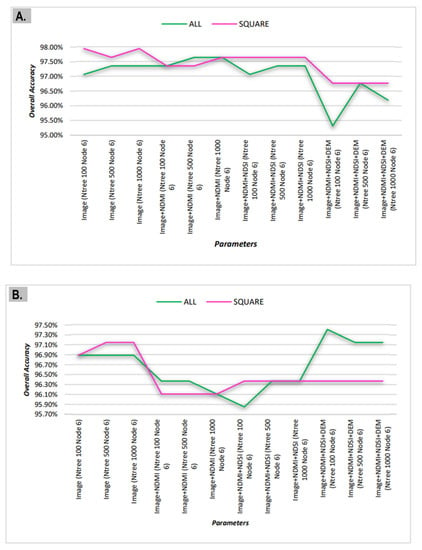
Figure 10.
Effect of mtry in RF classification accuracy: (A) Landsat-7 ETM+ and (B) Landsat-8 OLI images.
Furthermore, the overall accuracy average of each number of trees was high (Table 5). Overall, the accuracy rate did not significantly differ when using a tree parameter of 1000, 500, and 100, being 97.323%, 97.321%, and 97.068%, respectively. These results showed that the number of trees had no significant effect on the accuracy of mangrove and non-mangrove classifications.

Table 5.
Average overall accuracy of tree.
The RF classification accuracy of all models generated for Landsat-ETM+ and Landsat-8 OLI images is shown in Table 6 and Table 7. The highest accuracy for the Landsat-7 ETM+ image was found in the classification model using only the Image parameter (6 bands) with the number of trees = 100 and 1000, mtry square root, and a minimum node size of 6, which resulted in an overall accuracy of 97.95%, a kappa value of 0.972, and the producer accuracy for mangroves was 98.31%. The highest accuracy for the Landsat-8 OLI image was obtained using the classification model with a combination of Image + NDMI + NDSI + DEM parameters (tree number = 100, mtry all variables, the minimum number of node sizes = 6), which produced an overall accuracy of 97.41%, a kappa value of 0.943, and a producer accuracy for mangroves of 100.00%. Most interestingly, the use of DEM data provided a producer accuracy of 100% in mapping the mangrove class for Landsat-7 ETM+ and Landsat-8 OLI images. However, increasing producer accuracy for the mangrove class was not accompanied by an increase in the non-mangrove class producer accuracy, which tended to be low. This result showed that many non-mangrove objects were grouped into the mangrove class, which had implications for the overall accuracy of mangrove and non-mangrove classifications.

Table 6.
RF classification accuracy of all models of Landsat-7 ETM+.

Table 7.
RF classification accuracy of all models of Landsat-8 OLI.
The results of RF classification from the Landsat-7 ETM+ image using several combinations of parameters are shown in Figure 11, grouped into three classes, including mangrove (green), non-mangrove (gray), and water (blue), while black polygons indicate a ‘no data’ condition to accommodate the pixels of cloud and cloud shadows. The description of ‘no data’ from the classification results means there is no information on the pixel value of an object so that it does not need to be involved in the classification process because it will reduce the level of information details of the image used. Overall, the classification results of several parameters showed similarities regarding mangrove distribution where the number of pixels of mangrove objects with the parameter of Image (6 bands), Image + NDMI, Image + NDMI + NDSI and Image + NDMI + NDSI + DEM are 872737, 863333, 863874, and 885877 pixels, respectively. The use of the Image parameter (6 bands) from the Landsat-7 ETM+ image could highlight mangrove objects bordering water objects where many mangrove objects were identified along the coastline and riverbanks (Figure 11A). The combination of the Image + NDMI (Figure 11B), Image + NDMI + NDSI (Figure 11C), and Image + NDMI + NDSI + DEM (Figure 11D) parameters showed that the distributions of mangroves were relatively identical, but the combination of Image + NDMI + NDSI + DEM showed an apparently denser distribution of mangrove forests compared to the other parameters. Additionally, the image quality also greatly affected the classification results because more clouds and cloud shadows affect the reduced accuracy level of the classification results.
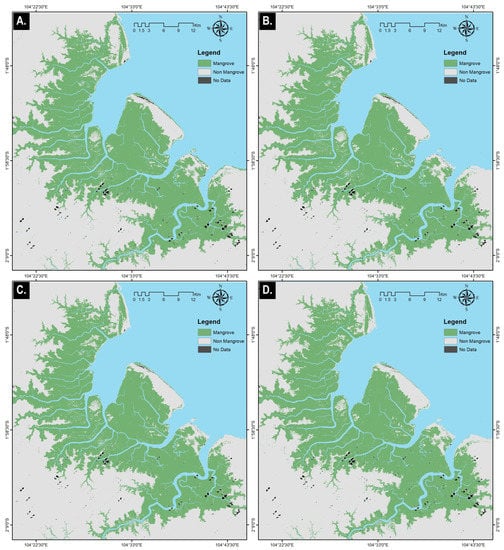
Figure 11.
Random forest classification results for all models in Landsat-7 ETM+ with the parameters (A) Image (6 bands), (B) Image + NDMI, (C) Image + NDMI + NDSI, and (D) Image + NDMI + NDSI + DEM.
Figure 12A–D show the results of the RF classification of the Landsat-8 OLI image using several parameters, including Image (7 bands), Image + NDMI, Image + NDMI + NDSI, and Image + NDMI + NDSI + DEM. Three main classes are produced, including mangroves (green color), non-mangroves (gray color), and aquatic (blue color). Overall, the classification results of all models were very similar, but the addition of the DEM parameter in the classification scheme appears to be quite effective in reducing or minimizing non-mangrove objects grouped into the mangrove class. Unlike the previous Landsat-7 ETM+ image classification that was constrained by image data quality, the classification process of the Landsat-8 OLI image was constrained by the relatively high heterogeneity of land cover such that many pixels were found mixed between mangrove and non-mangrove objects.
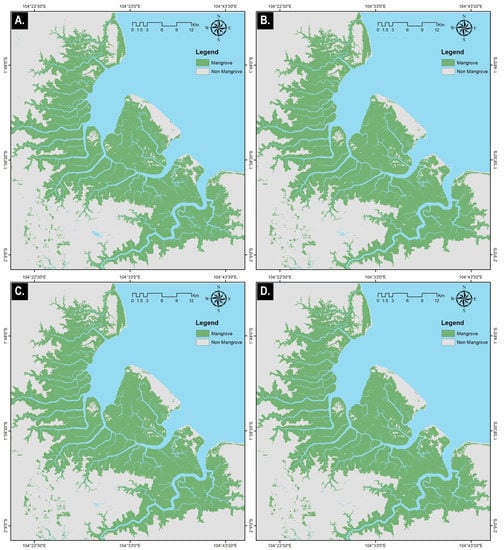
Figure 12.
Random forest classification results of all models in Landsat-8 OLI with the parameters (A) Image (7 bands), (B) Image + NDMI, (C) Image + NDMI + NDSI, and (D) Image + NDMI + NDSI + DEM.
4. Discussion
4.1. Distribution of Mangrove Forests in 2002
The results of the decision tree and RF classification using the optimal parameters from the 2002 Landsat-7 ETM+ image are shown in Figure 13A,B. The optimal combination of parameters chosen by the decision tree algorithm was NDMI + NDSI + DEM, while the parameters chosen by the RF algorithm was Image (6 bands) with the number of trees = 100, mtry square root, and nodes = 6. The distribution of mangrove forests using the two combinations of parameters had similarities, particularly in delineating the boundaries between mangroves and non-mangroves, but there were slight differences, particularly in the western and southern regions of the study area, where the distribution of mangroves using decision tree classification showed that several main mangrove pixels were lost, and conversely, the distribution of mangroves resulting from RF classification appears denser. The performance of decision tree classification could minimize mixed pixels quite well. The mixed-pixel phenomenon was more common in the RF classification results than in decision tree classification, particularly in the water pixels grouped into the mangrove class.
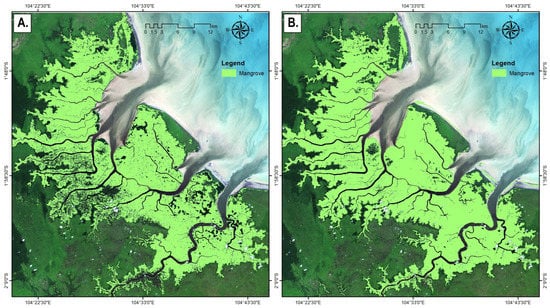
Figure 13.
Mangrove distribution of Sembilang National Park in 2002 based on (A) decision tree and (B) random forest algorithms.
The use of classification parameters from several spectral indices in the DT algorithm could effectively reduce the presence of mixed pixels, but it also had implications for the reduction of main mangrove pixels because the range of spectral values between mangrove and non-mangrove objects (particularly terrestrial vegetation) was relatively adjacent, such that several mangrove object pixels were also eliminated. This condition was not found in the RF classification results, in which the main mangrove pixels were not greatly reduced. Although the use of 1000 trees provided relatively high accuracy in all RF classification models, the choice of 100 trees was optimal for Landsat-7 ETM+ image because it does not require a longer classification process time.
An accuracy test was performed by calculating the overall accuracy value, kappa value, user accuracy, and producer accuracy. For the accuracy test of RF classification, three classes were tested, including mangrove, non-mangrove, and water. The results of the classification accuracy calculation using the DT and RF algorithms with the Landsat-7 ETM+ image are shown in Table 8 and Table 9, respectively. The overall accuracy of RF (99.12%) was higher than that of the DT algorithm (92.82%).

Table 8.
Accuracy assessment of the decision tree classification of Landsat 7 ETM+ (2002).

Table 9.
Accuracy assessment of the random forest classification of Landsat 7 ETM+ (2002).
4.2. Distribution of Mangrove Forests in 2019
Overall, the results of the DT and RF classifications using the optimal parameters of the Landsat-8 OLI image in 2019 were not very different from the classification results of the Landsat-7 ETM+ image (Figure 14A,B). The optimal combination of parameters was NDMI + NIR for the DT algorithm and Image (7 bands) + NDMI + NDSI + DEM for the RF algorithm with the number of trees = 100, mtry all variables, and the minimum node size = 6. Most interestingly, several oil palm plantation areas appeared in 2019 that were located adjacent to the mangrove forest area. This development provides a challenge in the classification process of land cover. The performance of DT classification could reduce the presence of mixed pixels quite well, particularly the pixels of mangroves mixed with oil palm plantation objects. In the RF classification, these pixels could be eliminated, but the results were not significant such that several pixels from the oil palm object were still considered mangrove forest objects.
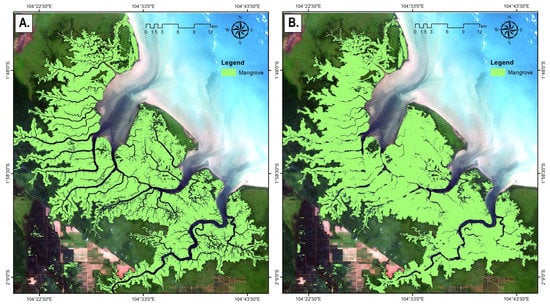
Figure 14.
Mangrove distributions of Sembilang National Park in 2019 (orange color) based on (A) decision tree and (B) random forest.
Additionally, using the RF algorithm, some pixels that were classified as mangroves in the Banyuasin Peninsula area were mostly eliminated/missing, and this result did not occur in the DT classification. The distribution of mangrove pixels was denser in 2019 than in 2002, probably because of the higher radiometric resolution of the Landsat-8 OLI image (12 bits) compared to Landsat-7 ETM+ image (8 bits). The RF algorithm classification results for 2019 showed that the mangroves were evenly distributed from the area around the coastline to the inner part of Sembilang National Park. The optimal parameter chosen could reduce mixed pixels (although not as a whole) and maintain the presence of the main mangrove pixels so that mangrove mapping could be more effective and have high accuracy.
The use of the DEM parameter in the DT classification of the Landsat-7 ETM+ image could increase the accuracy significantly (Table 3). However, this condition did not occur for the Landsat-8 OLI image, where the classification results using the DEM parameter tended to overestimate the mangrove class. Although non-mangrove pixels (particularly oil palm plantations) could be eliminated very well, it actually caused many missing mangrove pixels, such that the accuracy of classification decreased (Table 4). For the Landsat-8 OLI image, the overall accuracy of DT classification (98.34%) was higher than that of RF (97.79%), as shown in Table 10 and Table 11, respectively. Although non-mangrove (oil palm plantations) pixels were not greatly reduced using the DT classification model with a combination of NDMI + NIR parameters, a few of the main mangrove pixels were missing.

Table 10.
Accuracy assessment of decision tree classification of Landsat 8 OLI (2019).

Table 11.
Accuracy assessment of random forest classification of Landsat 8 OLI (2019).
4.3. Comparison of Classification Results Using Decision Tree Learning and RF
This study tried to develop a DT algorithm for identifying mangrove forests and compared it with a ‘robust’ classification algorithm, namely, RF. These two algorithms were applied to the mangrove area of Sembilang Banyuasin National Park, Indonesia. Spatially, the results of RF were denser than those of DT classification (Figure 13 and Figure 14). However, many mixed pixels remained between the mangrove and non-mangrove classes, particularly in oil palm plantation objects and other land vegetation that is considered mangrove forest objects. This problem can be overcome by using a DT algorithm that can reduce the mixed pixels.
The classification rules of the Landsat 7 ETM+ image were simpler than those of Landsat 8 OLI because, in 2002, there were few specifics of land cover, one of which was oil palm plantations around mangrove forests, such that the pixels of the non-mangrove class that were dominated by very dense terrestrial forest were easier to separate. Mangrove forests are plants that do not have a long growth phase, but have growth characteristics that only occur at one time. Based on field observations, the condition of mangroves in Sembilang National Park is dominated by true mangroves that are able to form pure stands and the majority are in the mature phase. Several parameters used in the DT classification also seem quite effective in separating mangrove and non-mangrove objects (Figure 8 and Figure 9). Parameters used for DT classification of Landsat-7 ETM+ image included NDMI, NDSI, and DEM, while for the Landsat-8 OLI image, NDMI, NIR, NDSI, and DEM were used. The use of DEM parameters was very effective in developing knowledge-based image classification because they can identify the spatial distribution patterns of land cover classes [50].
A slight difference emerged, particularly in the use of the NIR band parameter, which the Landsat-7 ETM+ image did not use in the classification scheme. This difference is obtained because, in 2002, the heterogeneity condition of land cover around the mangrove forest area was still relatively low such that the mangrove and non-mangrove objects could be separated properly using the NDMI parameter. Wilson et al. (2002) [35] explained that NDMI optimizes the contrast between the NIR band and the mid-infrared (1.550–1.750 m) band, which is more sensitive to the wetness of vegetation. Additionally, the combination of NDMI and other spectral indices can be more effective in describing mangrove forest habitat characteristics [21]. The average NDMI value was identified as 0.55 for Landsat-7 ETM+ image and 0.80 for Landsat-8 OLI image. These results indicated that the vegetation was healthy and had a dense canopy cover [73,90]. However, non-mangrove pixels remained, particularly in the terrestrial vegetation region, but were still grouped into the mangrove class. Therefore, these pixels must be reduced using other parameters.
Another spectral index proposed in this study, NDSI, can also distinguish mangrove and non-mangrove objects well. NDSI was used to reduce the spectral variability of the ground object by optimizing the presence of the SWIR band, which was very sensitive to the soil object compared to the NIR band [36]. NDSI and NDVI tend to have opposite characteristics, so NDSI can be used to detect open areas [36], particularly around mangrove forests. The classification results using the NDSI were very effective in assisting the removal of non-mangrove pixels classified in the mangrove class. However, the NDSI parameter still had problems in separating mangrove forests and water objects. This flaw can be seen from several non-mangrove pixels (water objects) that were classified into the mangrove class. Therefore, the DEM parameter must be used to remove the pixels of mangrove objects that were classified into non-mangrove classes (particularly on water objects). The classification results of each parameter used for the Landsat-7 ETM+ image along with the pixel anomaly conditions are shown in Figure 8.
Furthermore, by using the spectral capabilities of the NIR band, additional parameters in the DT classification of the Landsat-8 OLI image could distinguish between the reflectance values of mangrove forests and terrestrial vegetation (including oil palm plantations) quite well. The combination of NIR and NDSI bands was very optimal in reducing the presence of mixed pixels in the classification of mangroves and non-mangroves. The NIR band had a high sensitivity to leaf chlorophyll because NIR energy was mostly reflected to the sensor when it impinged upon the vegetation surface [37]. However, in this study, NIR band performance was also very effective in distinguishing between mangrove forests and terrestrial vegetation, while NDSI tends to be effective in identifying open land objects that were former oil palm plantations and/or oil palm that had just been planted. The difference between spectral profiles of mangrove forests and oil palm plantations in the NIR band is shown in Figure 15, where the effective reflectance values of mangrove forests were identified in the range of 0.267–0.35 with an average value of 0.287, while the effective reflectance values of oil palm plantation objects were identified in the range of 0.24–0.267 with an average value of 0.257. The classification rule of the Landsat-7 ETM+ image cannot be applied directly to the Landsat-8 OLI image and vice versa. This restriction is due to the difference in the radiometric resolution of the two images, greatly affecting the threshold value of the classification rule of each parameter. The classification rule that has been developed will be more optimal if it is applied to image data with the same radiometric resolution, in the same season (dry season is recommended for the tropics), and in adjacent acquisition times.
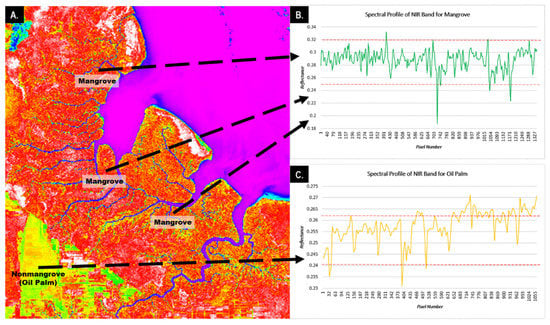
Figure 15.
(A) NIR band appearance of the Landsat-8 OLI image, (B) mangrove spectral profile of the NIR band, and (C) the non-mangrove (oil palm plantation) spectral profile of the NIR band.
The training data retrieval technique in the RF classification also greatly influenced the classification results. In this study, a combination of training data retrieval techniques was used based on the homogeneity of the pixel values and the heterogeneity of the object’s pixel values (training locations on the border of the image pixel values, particularly for non-mangrove objects). The training retrieval technique could provide better classification results. This finding is consistent with the previous study, in which the RF classification algorithm is included in the nonparametric classifier group so that it can ignore the normal distribution assumption of a dataset and provide better accuracy than the parametric-based classification [50,91].
Overall, the present DT and RF algorithms can separate mangrove and non-mangrove forest objects very well. However, there are still obstacles to separating non-mangrove objects that have the same spectral character as mangrove objects. The present DT algorithm has a better ability to reduce the presence of mixed pixels between mangrove and non-mangrove classes, but its use also has several consequences that must be faced, one of which being the presence of several mangrove pixels that risk being eliminated in the classification process. In addition, the DT algorithm developed was also effective in delineating the mangrove distribution because it could integrate satellite data and other ancillary data [26]. A simpler model of the DT is usually preferred over a more complex model.
The RF classification results show that the number of trees (100/500/1000) had little effect on classification result accuracy. This result is consistent with the study by Tridawati et al. (2020) [86], which stated that the number of trees had no significant effect on classification accuracy. The use of mtry = square root and mtry = all variables, provides a more optimal accuracy when combined with the selection of the right parameters. The use of mtry = square root showed effectiveness with the Image (6 bands) parameter for the Landsat-7 ETM+ image, while the use of mtry = all variables was very effective with the Image + NDMI + NDSI + DEM parameters for the Landsat-8 OLI image.
The use of DEM data has a crucial role in classifications using the RF algorithm. This role can be seen from the producer’s accuracy value of 100% for the mangrove class under all parameters involving DEM data, thus all mangrove classes can be mapped properly. Therefore, the use of DEM data in classifying mangrove and non-mangrove pixels is also very effective and optimal in increasing classification result accuracy, particularly when the RF algorithm is used. The DEM data used resulted from integrating DEM SRTM3 (Shuttle Radar Topography Mission) and AW3D-30m (ALOS: Advanced Land Observing Satellite, World 3D) data, which was developed by removing several error components (absolute bias, stripe noise, speckle noise, and tree height bias) [62].
5. Conclusions
The monitoring of mangrove forests with a fast and easy remote sensing technological approach is crucial in preserving mangroves. We succeeded in investigating the ability of DT learning and the RF algorithm to map mangrove forests in the best mangrove areas on one of the largest islands in Indonesia. The results of data processing and accuracy tests show that the classification results of the DT and RF algorithms in the two image datasets used show similarities regarding the spatial distribution of mangroves, and with acceptable accuracy. Additionally, some class anomalies could be reduced properly using the two classification algorithms (decision tree and random forest).
The DT classification algorithm with a parameter combination of NDMI + NDSI + DEM proposed in the DT algorithm is very effective in classifying mangrove and non-mangrove objects of the Landsat-7 ETM+ image, while the combination of NDMI + NIR parameters is very effectively used in classifying the Landsat-8 OLI image. The RF classification algorithm with the parameter of Image (6 bands), the number of trees = 100, mtry square root, and minimum node size = 6 provides the highest overall accuracy in classifying mangrove and non-mangrove objects in the Landsat-7 ETM+ image, while the combination of the Image (7 bands) + NDMI + NDSI + DEM parameters with the number of trees = 100, mtry all variables, and a minimum node size of 6, provides the highest overall accuracy in classifying mangrove and non-mangrove objects in the Landsat-8 OLI image. For the Landsat-7 ETM+ image, the overall classification accuracy of the RF algorithm, 99.12%, is higher than that of the DT, 92.82%, but for the Landsat-8 OLI image, the accuracy of the DT algorithm (98.34%) is slightly higher than that of the RF algorithm (97.79%). Overall, the RF algorithm tends to outperform the DT because it uses parameters that provide a higher producer accuracy in mapping mangrove forests.
Due to the limitations of the availability of SPOT 6/7 images in this case, this study only used SPOT 6/7 images to assist in determining the training sample and ground truth points. In future studies, Landsat-7 ETM+ and Landsat-8 OLI images can be combined with SPOT 6/7 images or other high-resolution images through image fusion techniques to obtain images with the most optimal spatial and radiometric resolution. Additionally, attention must be paid to the quality of satellite image data used, particularly disturbances from cloud and cloud shadows, to reduce noise and errors in the classification process. The number of land cover classes, the parameters used, and other ancillary data must be added. Method development should cover existing weaknesses and improve the classification accuracy so that the method can support nationwide mangrove monitoring and rehabilitation programs, particularly in Indonesia.
Author Contributions
Conceptualization, methodology, and formal analysis: A.D.P., K.W., A.D. and S.D.; software, visualization, investigation, and writing—original draft preparation, A.D.P.; supervision and writing—review and editing: K.W., A.D. and S.D. All authors have read and agreed to the published version of the manuscript.
Funding
This research was funded by National Research and Innovation Agency (BRIN) and the Indonesian Endowment Fund for Education (LPDP), Number: 21/IV/KS/06/2022, Institut Teknologi Nasional Bandung, Number 283a/B.05/LPPM-Itenas/VI/2022 and Institute for Research and Community Services (LPPM) of Institut Teknologi Bandung.
Acknowledgments
We thank the NASA/USGS for freely providing Landsat-7 ETM+ and Landsat-8 OLI images. Additionally, A.D.P acknowledges the National Research and Innovation Agency (BRIN) for a Ph.D. scholarship. We also thanks to Study Program of Geodesy and Geomatics Engineering, Faculty of Earth Science and Technology and Center for Remote Sensing, Institut Teknologi Bandung, Indonesia.
Conflicts of Interest
The authors declare no conflict of interest.
References
- Keim, A.P.; (National Research and Innovation Agency, Bogor, Indonesia). Personal communication, 2022.
- United Nations. The 17 Goals of SDGs, Department of Economic and Social Affairs. Available online: https://sdgs.un.org/goals/goal14 (accessed on 29 November 2021).
- Salampessy, M.L.; Febryano, I.G.; Martin, E.; Siahaya, M.E.; Papilaya, R. Cultural Capital of the Communities in the Mangrove Conservation in the Coastal Areas of Ambon Dalam Bay, Moluccas, Indonesia. Procedia Environ. Sci. 2015, 23, 222–229. [Google Scholar] [CrossRef][Green Version]
- Giri, C.; Ochieng, E.; Tieszen, L.L.; Zhu, Z.; Singh, A.; Loveland, T.; Masek, J.; Duke, N. Status and Distribution of Mangrove Forests of the World Using Earth Observation Satellite Data: Status and Distributions of Global Mangroves. Glob. Ecol. Biogeogr. 2011, 20, 154–159. [Google Scholar] [CrossRef]
- Kuenzer, C.; Bluemel, A.; Gebhardt, S.; Quoc, T.V.; Dech, S. Remote Sensing of Mangrove Ecosystems: A Review. Remote Sens. 2011, 3, 878–928. [Google Scholar] [CrossRef]
- Damastuti, E.; de Groot, R.; Debrot, A.O.; Silvius, M.J. Effectiveness of Community-Based Mangrove Management for Biodiversity Conservation: A Case Study from Central Java, Indonesia. Trees For. People 2022, 7, 100202. [Google Scholar] [CrossRef]
- Murdiyarso, D.; Purbopuspito, J.; Kauffman, J.B.; Warren, M.W.; Sasmito, S.D.; Donato, D.C.; Manuri, S.; Krisnawati, H.; Taberima, S.; Kurnianto, S. The Potential of Indonesian Mangrove Forests for Global Climate Change Mitigation. Nat. Clim. Chang. 2015, 5, 1089–1092. [Google Scholar] [CrossRef]
- Ministry of Marine Affairs and Fisheries Republic of Indonesia. Manfaat Hutan Mangrove bagi Kehidupan Manusia. Available online: https://kkp.go.id/brsdm/bdasukamandi/page/541-mangrove-dan-manfaatnya (accessed on 11 January 2022).
- Ulqodry, T.Z.; Aprianto, A.E.; Agussalim, A.; Aryawati, R.; Absori, A. Analisis Tutupan Mangrove Taman Nasional Berbak–Sembilang melalui Citra Landsat-8 dan Pemantauan LAI. J. Kelaut. Trop. 2021, 24, 393–401. [Google Scholar] [CrossRef]
- Marlianingrum, P.R.; Kusumastanto, T.; Adrianto, L.; Fahrudin, A. Valuing Habitat Quality for Managing Mangrove Ecosystem Services in Coastal Tangerang District, Indonesia. Mar. Policy 2021, 133, 104747. [Google Scholar] [CrossRef]
- Noor, Y.R.; Khazali, M.; Suryadiputra, I.N.N. Panduan Pengenalan Mangrove di Indonesia; Ditjen PHKA, Wetlands International, Indonesia Programme: Bogor, Indonesia, 2006. [Google Scholar]
- Giesen, W. Indonesia’s Mangroves: An Update on Remaining Area and Main Management Issues. Available online: https://www.researchgate.net/publication/303143263_Indonesia’s_mangrove_an_update_on_remaining_area_and_main_management_issues (accessed on 12 May 2022).
- Darmawan, S.; Sari, D.K.; Wikantika, K.; Tridawati, A.; Hernawati, R.; Sedu, M.K. Identification Before-after Forest Fire and Prediction of Mangrove Forest Based on Markov-Cellular Automata in Part of Sembilang National Park, Banyuasin, South Sumatra, Indonesia. Remote Sens. 2020, 12, 3700. [Google Scholar] [CrossRef]
- Lee, S.Y.; Dunn, R.J.K.; Young, R.A.; Connolly, R.M.; Dale, P.E.R.; Dehayr, R.; Lemckert, C.J.; Mckinnon, S.; Powell, B.; Teasdale, P.R.; et al. Impact of Urbanization on Coastal Wetland Structure and Function. Austral Ecol. 2006, 31, 149–163. [Google Scholar] [CrossRef]
- Nagelkerken, I.; Blaber, S.J.M.; Bouillon, S.; Green, P.; Haywood, M.; Kirton, L.G.; Meynecke, J.-O.; Pawlik, J.; Penrose, H.M.; Sasekumar, A.; et al. The Habitat Function of Mangroves for Terrestrial and Marine Fauna: A Review. Aquat. Bot. 2008, 89, 155–185. [Google Scholar] [CrossRef]
- Fatoyinbo, T.E.; Simard, M.; Washington-Allen, R.A.; Shugart, H.H. Landscape-Scale Extent, Height, Biomass, and Carbon Estimation of Mozambique’s Mangrove Forests with Landsat ETM+ and Shuttle Radar Topography Mission Elevation Data: Mangrove Forest Structure Estimation. J. Geophys. Res. Biogeosci. 2008, 113, 1–13. [Google Scholar] [CrossRef]
- Eddy, S.; Milantara, N.; Sasmito, S.D.; Kajita, T.; Basyuni, M. Anthropogenic Drivers of Mangrove Loss and Associated Carbon Emissions in South Sumatra, Indonesia. Forests 2021, 12, 187. [Google Scholar] [CrossRef]
- Iqbal, M. Pemantauan Kawasan Sembilang No. 7, Juli/Agustus 2003. Laporan Teknis No. 74. Proyek Konservasi Terpadu Lahan Basah Pesisir Berbak Sembilang; Wetlands International—Asia Pacific Indonesia Programme: Bogor, Indonesia, 2003. [Google Scholar]
- Iqbal, M. Pemantauan Kawasan Sembilang No. 9, Februari 2004. Laporan Teknis No. 82 Proyek Konservasi Terpadu Lahan Basah Pesisir Berbak Sembilang; Wetland International Indonesia Programme: Bogor, Indonesia, 2004. [Google Scholar]
- Pemerintah Republik Indonesia. Undang-Undang Nomor 5 Tahun 1990 Tentang Konservasi Sumber Daya Alam Hayati Dan Ekosistemnya; Pemerintah Republik Indonesia: Jakarta, Indonesia, 1990; pp. 1–26.
- Zhang, X.; Treitz, P.M.; Chen, D.; Quan, C.; Shi, L.; Li, X. Mapping Mangrove Forests Using Multi-Tidal Remotely-Sensed Data and a Decision-Tree-Based Procedure. Int. J. Appl. Earth Obs. Geoinf. 2017, 62, 201–214. [Google Scholar] [CrossRef]
- Rahadian, A.; Prasetyo, L.B.; Setiawan, Y.; Wikantika, K. A Historical Review of Data and Information of Indonesian Mangroves Area. Media Konserv. 2019, 24, 163–178. [Google Scholar] [CrossRef]
- Lillesand, T.M.; Kiefer, R.W.; Chipman, J.W. Remote Sensing and Image Interpretation, 7th ed.; John Wiley & Sons, Inc.: Hoboken, NJ, USA, 2015. [Google Scholar]
- Heumann, B.W. An Object-Based Classification of Mangroves Using a Hybrid Decision Tree-Support Vector Machine Approach. Remote Sens. 2011, 3, 2440–2460. [Google Scholar] [CrossRef]
- Jamaluddin, I.; Chen, Y.-N.; Ridha, S.M.; Mahyatar, P.; Ayudyanti, A.G. Two Decades Mangroves Loss Monitoring Using Random Forest and Landsat Data in East Luwu, Indonesia (2000–2020). Geomatics 2022, 2, 282–296. [Google Scholar] [CrossRef]
- Liu, K.; Li, X.; Shi, X.; Wang, S. Monitoring Mangrove Forest Changes Using Remote Sensing and GIS Data with Decision-Tree Learning. Wetlands 2008, 28, 336–346. [Google Scholar] [CrossRef]
- Chen, C.-F.; Son, N.-T.; Chang, N.-B.; Chen, C.-R.; Chang, L.-Y.; Valdez, M.; Centeno, G.; Thompson, C.; Aceituno, J. Multi-Decadal Mangrove Forest Change Detection and Prediction in Honduras, Central America, with Landsat Imagery and a Markov Chain Model. Remote Sens. 2013, 5, 6408–6426. [Google Scholar] [CrossRef]
- Tran, H.; Tran, T.; Kervyn, M. Dynamics of Land Cover/Land Use Changes in the Mekong Delta, 1973–2011: A Remote Sensing Analysis of the Tran Van Thoi District, Ca Mau Province, Vietnam. Remote Sens. 2015, 7, 2899–2925. [Google Scholar] [CrossRef]
- Winarso, G.; Purwanto, A.D. Evaluation of Mangrove Damage Level Based on Landsat 8 Image. Int. J. Remote Sens. Earth Sci. 2017, 11, 105. [Google Scholar] [CrossRef][Green Version]
- Purwanto, A.D.; Asriningrum, W. Identification of Mangrove Forests Using Multispectral Satellite Imageries. Int. J. Remote Sens. Earth Sci. 2019, 16, 63. [Google Scholar] [CrossRef]
- Xiao, H.; Su, F.; Fu, D.; Lyne, V.; Liu, G.; Pan, T.; Teng, J. Optimal and Robust Vegetation Mapping in Complex Environments Using Multiple Satellite Imagery: Application to Mangroves in Southeast Asia. Int. J. Appl. Earth Obs. Geoinf. 2021, 99, 102320. [Google Scholar] [CrossRef]
- Yu, T.; Li, X.; Zhang, Y.; Zhao, F.; Gu, X.; Zhu, L.; Wang, P.; Min, X. Comparison of the Influence Factors on NDVI for CCD Camera and WFI Imager on CBERS-02. Sci. China Ser. E-Technol. Sci. 2005, 48 (Suppl. S2), 100–115. [Google Scholar]
- Chen, D.; Huang, J.; Jackson, T.J. Vegetation Water Content Estimation for Corn and Soybeans Using Spectral Indices Derived from MODIS Near- and Short-Wave Infrared Bands. Remote Sens. Environ. 2005, 98, 225–236. [Google Scholar] [CrossRef]
- Huang, J.; Chen, D.; Cosh, M.H. Sub-pixel Reflectance Unmixing in Estimating Vegetation Water Content and Dry Biomass of Corn and Soybeans Cropland Using Normalized Difference Water Index (NDWI) from Satellites. Int. J. Remote Sens. 2009, 30, 2075–2104. [Google Scholar] [CrossRef]
- Wilson, E.H.; Sader, S.A. Detection of Forest Harvest Type Using Multiple Dates of Landsat TM Imagery. Remote Sens. Environ. 2002, 80, 385–396. [Google Scholar] [CrossRef]
- Rogers, A.S.; Kearney, M.S. Reducing Signature Variability in Unmixing Coastal Marsh Thematic Mapper Scenes Using Spectral Indices. Int. J. Remote Sens. 2004, 25, 2317–2335. [Google Scholar] [CrossRef]
- Nguyen, C.T.; Chidthaisong, A.; Kieu Diem, P.; Huo, L.-Z. A Modified Bare Soil Index to Identify Bare Land Features during Agricultural Fallow-Period in Southeast Asia Using Landsat 8. Land 2021, 10, 231. [Google Scholar] [CrossRef]
- Jensen, J.R.; Lulla, K. Introductory Digital Image Processing: A Remote Sensing Perspective. Geocarto Int. 1987, 2, 659. [Google Scholar] [CrossRef]
- Li, H.T.; Gu, H.Y.; Han, Y.S.; Yang, J.H. Object-Oriented Classification of Polarimetric SAR Imagery Based on Statistical Region Merging and Support Vector Machine. In Proceedings of the 2008 International Workshop on Earth Observation and Remote Sensing Applications, Beijing, China, 30 June–2 July 2008; pp. 1–6. [Google Scholar]
- Sutanto, A.; Trisakti, B.; Arimurthy, A.M. Perbandingan Klasifikasi Berbasis Obyek Dan Klasifikasi Berbasis Piksel Pada Data Citra Satelit Synthetic Aperture Radar Untuk Pemetaan Lahan. J. Penginderaan Jauh. 2014, 11, 13. [Google Scholar]
- Hay, G.J.; Castilla, G. Object-Based Image Analysis: Strengths, Weaknesses, Opportunities and Threats (SWOT). Int. Arch. Photogramm. Remote Sens. Spat. Inf. Sci. 2006, 4–5. [Google Scholar]
- Madanguit, C.J.G.; Oñez, P.J.L.; Tan, H.G.; Villanueva, M.D.; Ordaneza, J.E.; Aurelio, R.M.; Novero, A.U. Application of Support Vector Machine (SVM) and Quick Unbiased Efficient Statistical Tree (QUEST) Algorithms on Mangrove and Agricultural Resource Mapping using LiDAR Data Sets. Int. J. Appl. Environ. Sci. 2017, 12, 973–6077. [Google Scholar]
- Firmansyah, S.; Gaol, J.L.; Susilo, S.B. Perbandingan Klasifikasi SVM dan Decision Tree untuk Pemetaan Mangrove Berbasis Objek Menggunakan Citra Satelit Sentinel-2B di Gili Sulat, Lombok Timur. J. Nat. Resour. Environ. Manag. 2019, 9, 746–757. [Google Scholar]
- Ma, C.; Ai, B.; Zhao, J.; Xu, X.; Huang, W. Change Detection of Mangrove Forests in Coastal Guangdong during the Past Three Decades Based on Remote Sensing Data. Remote Sens. 2019, 11, 921. [Google Scholar] [CrossRef]
- Breiman, L. Random Forests. Mach. Learn. 2001, 45, 5–32. [Google Scholar] [CrossRef]
- Jhonnerie, R. Klasifikasi Mangrove Berbasis Objek dan Piksel Menggunakan Citra Satelit Multispektral di Sungai Kembung, Bengkalis, Provinsi Riau; Institut Pertanian Bogor: Bogor, Indonesia, 2015. [Google Scholar] [CrossRef]
- Mondal, P.; Liu, X.; Fatoyinbo, T.E.; Lagomasino, D. Evaluating Combinations of Sentinel-2 Data and Machine-Learning Algorithms for Mangrove Mapping in West Africa. Remote Sens. 2019, 11, 2928. [Google Scholar] [CrossRef]
- Lubis, I.R.; Suryadiputra, I.N.N. Upaya Pengelolaan Terpadu Hutan Rawa Gambut Bekas Terbakar Diwilayah Berbak-Sembilang. Prosiding Semiloka; CIFOR: Bogor, Indonesia, 2004; pp. 105–119. [Google Scholar]
- Purwadhi, F.S.H. Interpretasi Citra Digital; Gramedia Widiasarana: Jakarta, Indonesia, 2001. [Google Scholar]
- Lu, D.; Weng, Q. A Survey of Image Classification Methods and Techniques for Improving Classification Performance. Int. J. Remote Sens. 2007, 28, 823–870. [Google Scholar] [CrossRef]
- Kamaruddin, N.A.; Fujii, S. Mangrove Forest Classification Using Decision Tree-Learning Method. World Appl. Sci. J. 2017, 35, 1821–1825. [Google Scholar] [CrossRef]
- Suwignyo, R.A.; Ulqodry, T.Z.; Miyakawa, H. Mangrove Plant Condition in the Greenbelt Area of Banyuasin Peninsula, Sembilang National Park, South Sumatra, Indonesia and Its Restoration Plan. Chiang Mai Univ. J. Nat. Sci. 2012, 11, 123–134. [Google Scholar]
- RSIS (Ramsar Sites Information Service). Ramsar Sites in Indonesia (Information Sheet on Ramsar Wetlands—Berbak National Park). 1991. Available online: https://rsis.ramsar.org/RISapp/files/RISrep/ID554RIS.pdf (accessed on 13 July 2021).
- RSIS (Ramsar Sites Information Service). Information Sheet on Ramsar Wetlands (RIS)—Sembilang National Park. 2012. Available online: https://rsis.ramsar.org/RISapp/files/RISrep/ID1945RIS.pdf (accessed on 13 July 2021).
- Nurhayat, O.D.; Yanto, D.H.Y.; Ardiati, F.C.; Ramadhan, K.P.; Anita, S.H.; Okano, H.; Watanabe, T. Bioprospecting Three Newly Isolated White-Rot Fungi from Berbak-Sembilang National Park, Indonesia for Biodecolorization of Anthraquinone and Azo Dyes. Biodivers. J. Biol. Divers. 2022, 23, 2. [Google Scholar] [CrossRef]
- Ulqodry, T.Z.; Suganda, A.; Agussalim, A.; Aryawati, R.; Absori, A. Estimasi Serapan Karbon Mangrove Melalui Proses Fotosintesis Di Taman Nasional Berbak-Sembilang. J. Kelaut. Nas. 2020, 15, 77–84. [Google Scholar] [CrossRef]
- Mongabay. Mangrove Yang Memberi Harapan Nelayan Sembilang. Available online: https://www.mongabay.co.id/2018/08/01/mangrove-yang-memberi-harapan-nelayan-sembilang (accessed on 30 October 2022).
- Theresia; Boer, M.; Pratiwi, N. Pengelolaan Ekosistem Mangrove Di Taman Nasional Sembilang Kabupaten Banyuasin Provinsi Sumatera Selatan. Master’s Thesis, Institut Pertanian Bogor, Bogor, Indonesia, 2016. [Google Scholar]
- Verheugt, W.J.M.; Purwoko, A.; Danielsen, F.; Skov, H.; Kadarisman, R. Integrating Mangrove and Swamp Forests Conservation with Coastal Lowland Development; the Banyuasin Sembilang Swamps Case Study, South Sumatra Province, Indonesia. Landsc. Urban Plan. 1991, 20, 85–94. [Google Scholar] [CrossRef]
- Statistics Indonesia. Banyuasin Regency in Figures 2022. 2020. Available online: https://banyuasinkab.bps.go.id (accessed on 15 July 2022).
- Pariwono, J.I. Australian Co-Operative Programmes in Marine Sciences: Tides and Tidal Phenomena in the ASEAN Region; Flinders University of South Australia: Queensland, Australia, 1985. [Google Scholar]
- Yamazaki, D.; Ikeshima, D.; Tawatari, R.; Yamaguchi, T.; O’Loughlin, F.; Neal, J.C.; Sampson, C.C.; Kanae, S.; Bates, P.D. A High-Accuracy Map of Global Terrain Elevations: Accurate Global Terrain Elevation Map. Geophys. Res. Lett. 2017, 44, 5844–5853. [Google Scholar] [CrossRef]
- Congedo, L. Semi-automatic classification plugin documentation. Release 2016, 4, 29. [Google Scholar]
- Congedo, L. Semi-Automatic Classification Plugin: A Python tool for the download and processing of remote sensing images in QGIS. J. Open Source Softw. 2021, 6, 3172. [Google Scholar] [CrossRef]
- Kustiyo; Dewanti, R.; Lolitasari, I. Pengembangan Metoda Koreksi Radiometrik Citra Spot 4 Multi-Spektral Dan Multi-Temporal Untuk Mosaik Citra. Pros. Semin. Nas. Penginderaan Jauh 2014, 1, 79–87. [Google Scholar]
- Kamal, M.; Muhammad, F.H.; Mahardhika, S.A. Effect of Image Radiometric Correction Levels of Landsat Images to the Land Cover Maps Resulted from Maximum Likelihood Classification. E3S Web Conf. 2020, 153, 02004. [Google Scholar] [CrossRef]
- Begeman, C.; Helder, D.; Leigh, L.; Pinkert, C. Relative Radiometric Correction of Pushbroom Satellites Using the Yaw Maneuver. Remote Sens. 2022, 14, 2820. [Google Scholar] [CrossRef]
- Doxani, G.; Vermote, E.; Roger, J.-C.; Gascon, F.; Adriaensen, S.; Frantz, D.; Hagolle, O.; Hollstein, A.; Kirches, G.; Li, F.; et al. Atmospheric Correction Inter-Comparison Exercise. Remote Sens. 2018, 10, 352. [Google Scholar] [CrossRef]
- Ilori, C.; Pahlevan, N.; Knudby, A. Analyzing Performances of Different Atmospheric Correction Techniques for Landsat 8: Application for Coastal Remote Sensing. Remote Sens. 2019, 11, 469. [Google Scholar] [CrossRef]
- Friedl, M.A.; Brodley, C.E. Decision Tree Classification of Land Cover from Remotely Sensed Data. Remote Sens. Environ. 1997, 61, 399–409. [Google Scholar] [CrossRef]
- Simard, M.; Saatchi, S.S.; De Grandi, G. The Use of Decision Tree and Multiscale Texture for Classification of JERS-1 SAR Data over Tropical Forest. IEEE Trans. Geosci. Remote Sens. 2000, 38, 2310–2321. [Google Scholar] [CrossRef]
- Miettinen, J.; Liew, S.C.; Kwoh, L.K. Usability of Sentinel-1 dual polarization C-band data for plantation detection in insular Southeast Asia. In Proceedings of the 36th Asian Conference on Remote Sensing (ACRS2015), Quezon City, Philippines, 24–28 October 2015. [Google Scholar]
- Sari, I.L.; Weston, C.J.; Newnham, G.J.; Volkova, L. Developing Multi-Source Indices to Discriminate between Native Tropical Forests, Oil Palm and Rubber Plantations in Indonesia. Remote Sens. 2021, 14, 3. [Google Scholar] [CrossRef]
- Loh, W.-Y. Fifty Years of Classification and Regression Trees: Fifty Years of Classification and Regression Trees. Int. Stat. Rev. 2014, 82, 329–348. [Google Scholar] [CrossRef]
- Battista, K.; Patte, K.A.; Diao, L.; Dubin, J.A.; Leatherdale, S.T. Using Decision Trees to Examine Environmental and Behavioural Factors Associated with Youth Anxiety, Depression, and Flourishing. Int. J. Environ. Res. Public. Health 2022, 19, 10873. [Google Scholar] [CrossRef] [PubMed]
- Hodgson, M.E.; Jensen, J.R.; Tullis, J.A.; Riordan, K.D.; Archer, C.M. Synergistic Use of Lidar and Color Aerial Photography for Mapping Urban Parcel Imperviousness. Photogramm. Eng. Remote Sens. 2003, 69, 973–980. [Google Scholar] [CrossRef]
- L3 Harris Geospatial Documentation Center. Profiles and Plots. Available online: https://www.l3harrisgeospatial.com/docs/profiles.htm (accessed on 14 May 2022).
- Madden, C.K. Contributions to Remote Sensing of Shallow Water Depth with the Worldview-2 Yellow Band. Master’s Thesis, Naval Postgraduate School, Monterey, CA, USA, March 2011. [Google Scholar]
- Diniz, C.; Cortinhas, L.; Nerino, G.; Rodrigues, J.; Sadeck, L.; Adami, M.; Souza-Filho, P. Brazilian Mangrove Status: Three Decades of Satellite Data Analysis. Remote Sens. 2019, 11, 808. [Google Scholar] [CrossRef]
- Cutler, D.R.; Edwards, T.C.; Beard, K.H.; Cutler, A.; Hess, K.T.; Gibson, J.; Lawler, J.J. RANDOM FORESTS FOR CLASSIFICATION IN ECOLOGY. Ecology 2007, 88, 2783–2792. [Google Scholar] [CrossRef]
- Beijma, S.; Comber, A.; Lamb, A. Random Forest Classification of Salt Marsh Vegetation Habitats Using Quad-Polarimetric Airborne SAR, Elevation and Optical RS Data. Remote Sens. Environ. 2014, 149, 118–129. [Google Scholar] [CrossRef]
- Kulkarni, A.D.; Lowe, B. Random Forest Algorithm for Land Cover Classification. Int. J. Recent Innov. Trends Comput. Commun. 2016, 4, 7. [Google Scholar]
- Phan, T.N.; Kuch, V.; Lehnert, L.W. Land Cover Classification Using Google Earth Engine and Random Forest Classifier—The Role of Image Composition. Remote Sens. 2020, 12, 2411. [Google Scholar] [CrossRef]
- Kustiyo. Machine Learning Technique Using Python for Remote Sensing Land Cover Classification. Available online: https://www.youtube.com/watch?v=eaKJEjYacdY. (accessed on 11 December 2021).
- Köthe, U. The VIGRA Image Analysis Library; University of Heidelberg: Heidelberg, Germany, 2012. [Google Scholar]
- Tridawati, A.; Wikantika, K.; Susantoro, T.M.; Harto, A.B.; Darmawan, S.; Yayusman, L.F.; Ghazali, M.F. Mapping the Distribution of Coffee Plantations from Multi-Resolution, Multi-Temporal, and Multi-Sensor Data Using a Random Forest Algorithm. Remote Sens. 2020, 12, 3933. [Google Scholar] [CrossRef]
- Immitzer, M.; Atzberger, C.; Koukal, T. Tree Species Classification with Random Forest Using Very High Spatial Resolution 8-Band WorldView-2 Satellite Data. Remote Sens. 2012, 4, 2661–2693. [Google Scholar] [CrossRef]
- Guan, H.; Li, J.; Chapman, M.; Deng, F.; Ji, Z.; Yang, X. Integration of Orthoimagery and Lidar Data for Object-Based Urban Thematic Mapping Using Random Forests. Int. J. Remote Sens. 2013, 34, 5166–5186. [Google Scholar] [CrossRef]
- Colditz, R. An Evaluation of Different Training Sample Allocation Schemes for Discrete and Continuous Land Cover Classification Using Decision Tree-Based Algorithms. Remote Sens. 2015, 7, 9655–9681. [Google Scholar] [CrossRef]
- Beckschäfer, P. Obtaining Rubber Plantation Age Information from Very Dense Landsat TM & ETM + Time Series Data and Pixel-Based Image Compositing. Remote Sens. Environ. 2017, 196, 89–100. [Google Scholar] [CrossRef]
- Foody, G.M. Status of Land Cover Classification Accuracy Assessment. Remote Sens. Environ. 2002, 80, 185–201. [Google Scholar] [CrossRef]
Disclaimer/Publisher’s Note: The statements, opinions and data contained in all publications are solely those of the individual author(s) and contributor(s) and not of MDPI and/or the editor(s). MDPI and/or the editor(s) disclaim responsibility for any injury to people or property resulting from any ideas, methods, instructions or products referred to in the content. |
© 2022 by the authors. Licensee MDPI, Basel, Switzerland. This article is an open access article distributed under the terms and conditions of the Creative Commons Attribution (CC BY) license (https://creativecommons.org/licenses/by/4.0/).
